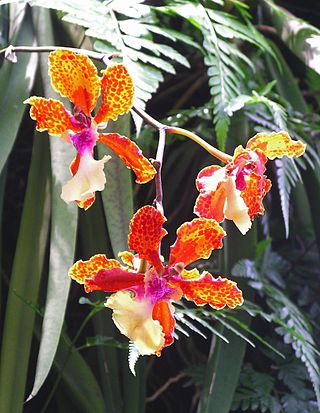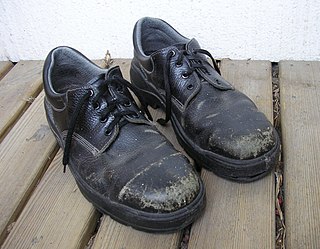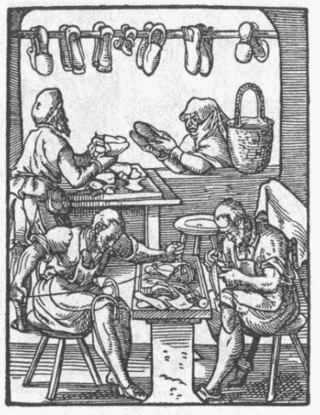
A klomp (plural klompen) is a whole-foot clog from the Netherlands. Along with tulips and windmills, they are strongly associated with the country and are considered to be a national symbol of the Netherlands.

A klomp (plural klompen) is a whole-foot clog from the Netherlands. Along with tulips and windmills, they are strongly associated with the country and are considered to be a national symbol of the Netherlands.
Approximately three million pairs of klompen are made each year. [1] They are sold throughout the Netherlands. A large part of the market is for tourist souvenirs, though some Dutch people, particularly farmers and market gardeners, still wear them for everyday use. Outside the tourist industry, klompen can be found in local tool shops, local tourist shops and garden centers.
The traditional all-wooden Dutch clogs have been officially accredited as safety shoes with the CE mark and can withstand almost any penetration including sharp objects and concentrated acids. They are actually safer than steel-capped protective shoes in some circumstances, as the wood cracks rather than dents in extreme accidents, allowing easy removal of the clog and not continued pressure on the toes by the (edge of the) steel nose. [2]

Amsterdam is the capital and most populated city of the Netherlands. It has a population of 921,402 within the city proper, 1,457,018 in the urban area and 2,480,394 in the metropolitan area. Located in the Dutch province of North Holland, Amsterdam is colloquially referred to as the "Venice of the North", for its large number of canals, now designated a UNESCO World Heritage Site.

While recreational use, possession and trade of non-medicinal drugs described by the Opium Law are all technically illegal under Dutch law, official policy since the late 20th century has been to openly tolerate all recreational use while tolerating the other two under certain circumstances. This pragmatic approach was motivated by the idea that a drug-free Dutch society is unrealistic and unattainable, and efforts would be better spent trying to minimize harm caused by recreational drug use. As a result of this gedoogbeleid, the Netherlands is typically seen as much more tolerant of drugs than most other countries.

The Hague is a city and municipality of the Netherlands, situated on the west coast facing the North Sea. The Hague is the capital of the province of South Holland. The Hague is the country's administrative centre and its seat of government, and while the official capital of the Netherlands is Amsterdam, The Hague has been described as the country's de facto capital.

Ice skates are metal blades attached underfoot and used to propel the bearer across a sheet of ice while ice skating.

A tourist attraction is a place of interest that tourists visit, typically for its inherent or an exhibited natural or cultural value, historical significance, natural or built beauty, offering leisure and amusement.

Sint-Oedenrode is a town in the province of North Brabant.

Tourism in Singapore is a major industry and contributor to the Singaporean economy.

A steel-toe boot is a durable boot or shoe that has a protective reinforcement in the toe which protects the foot from falling objects or compression. Safety shoes are effective in keeping the feet of industrial workers safe from sharp and heavy objects while working in factories.

Clogs are a type of footwear made in part or completely from wood. Used in many parts of the world, their forms can vary by culture, but often remained unchanged for centuries within a culture.

Tulip festivals are held in several cities around the world, mostly in North America, usually in cities with a Dutch heritage such as Albany, New York, Ottawa, Ontario; Gatineau, Quebec; Montreal, Quebec; Holland, Michigan; Lehi, Utah; Orange City, Iowa; Pella, Iowa; Mount Vernon, Washington; and Woodburn, Oregon, and in other countries such as New Zealand, Australia, India, and England. The tulips are considered a welcome harbinger of spring, and a tulip festival permits residents to see them at their best advantage. The festivals are also popular tourist attractions. The tulips are displayed throughout the cities. In certain years the peak of tulips does not coincide with the actual festival due to climatic conditions.

Floristry is the production, commerce, and trade in flowers. It encompasses flower care and handling, floral design and arrangement, merchandising, production, display and flower delivery. Wholesale florists sell bulk flowers and related supplies to professionals in the trade. Retail florists offer fresh flowers and related products and services to consumers. The first flower shop in the United States opened prior to 1851.

Geta (下駄) are traditional Japanese footwear resembling flip-flops. A kind of sandal, geta have a flat wooden base elevated with up to three "teeth", held on the foot with a fabric thong, which keeps the foot raised above the ground.

Sandals are an open type of shoe, consisting of a sole held to the wearer's foot by straps going over the instep and around the ankle. Sandals can also have a heel. While the distinction between sandals and other types of footwear can sometimes be blurry, the common understanding is that a sandal leaves all or most of the foot exposed. People may choose to wear sandals for several reasons, among them comfort in warm weather, economy, and as a fashion choice. Usually, people wear sandals in warmer climates or during warmer parts of the year in order to keep their feet cool and dry. The risk of developing athlete's foot is lower than with enclosed shoes, and the wearing of sandals may be part of the treatment regimen for such an infection.

Shoemaking is the process of making footwear.

De Klinge is a Belgian town and part of the municipality of Sint-Gillis-Waas in the province of East Flanders (Oost-Vlaanderen), is located on the border with the Netherlands province of Zeeland and within the non-administrative region known as the Waasland or the Land van Waas. On the Dutch side of the border the town is called Clinge and is part of the municipality of Hulst. Sint-Niklaas is 10 kilometres south of De Klinge. The nearest large Belgian city is Antwerp (Antwerpen) to the east. The town is bordered by many forests, including the Stropersbos, which are excellent for cycling and walking.

Clog dancing is a form of step dance characterised by the wearing of inflexible, wooden soled clogs. Clog dancing developed into differing intricate forms both in Wales and also in the North of England. Welsh clog dancing mainly originates from various slate mines where workers would compete against each other during work breaks. Northern English traditional clog dancing originates from Lancashire, Yorkshire, County Durham, Northumberland and the Lake District.

Antwerp is a city and a municipality in the Flemish Region of Belgium. It is the capital and largest city of Antwerp Province, and the third largest city in Belgium by area at 204.51 km2 (78.96 sq mi) after Tournai and Couvin. With a population of 536,079, it is the most populous municipality in Belgium, and with a metropolitan population of over 1,200,000 people, the country's second-largest metropolitan region after Brussels.

The International Wooden Shoe Museum Eelde is a museum in Eelde, the Netherlands, for clogs, clog-making equipment and machinery. It has the largest collection of wooden footwear in the world.

A British clog is a wooden-soled clog from Great Britain. The uppers are typically leather, and many variations exist in style and fastening.
Traditional dancing in the Netherlands is often called "Folkloristisch", sometimes "Boerendansen" ("farmer-dancing") or "Klompendansen". Wooden shoes are worn as an essential part of the traditional costume for Dutch clogging, or Klompendanskunst. Clogs for dancing are made lighter than the traditional 700-year-old design. The soles are made from ash wood, and the top part is cut lower by the ankle. Dancers create a rhythm by tapping the toes and heels on a wooden floor.